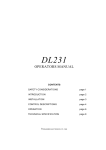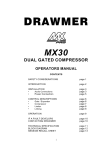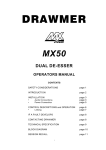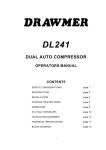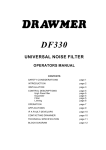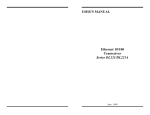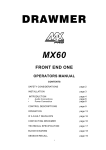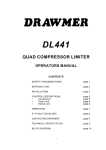Download Drawmer DL221 Specifications
Transcript
DL221 OPERATORS MANUAL and DL120 CONTENTS SAFETY CONSIDERATIONS page 1 INTRODUCTION page 2 INSTALLATION page 3 CONTROL DESCRIPTIONS page 4 OPERATION page 6 TECHNICAL SPECIFICATION page 8 h DRAWMER ELECTRONICS LTD. 1990 COPYRIGHT This manual is copyrighted © 1990 by Drawmer Electronics, Ltd. With all rights reserved. Under copyright laws, this manual may not be duplicated in whole or in part without the written consent of Drawmer. ONE YEAR LIMITED WARRANTY Drawmer Electronics Ltd., warrants the Drawmer DL221 audio processor to conform substantially to the specifications of this manual for a period of one year from the original date of purchase when used in accordance with the specifications detailed in this manual. In the case of a valid warranty claim, your sole and exclusive remedy and Drawmer’s entire liability under any theory of liability will be to, at Drawmer’s discretion, repair or replace the product without charge, or, if not possible, to refund the purchase price to you. This warranty is not transferable. It applies only to the original purchaser of the product. For warranty service please call your local Drawmer dealer. Alternatively call Drawmer Electronics Ltd. at +44 (0)1709 527574. Then ship the defective product, with transportation and insurance charges pre-paid, to Drawmer Electronics Ltd., Coleman Street, Parkgate, Rotherham, S62 6EL UK. Write the RA number in large letters in a prominent position on the shipping box. Enclose your name, address, telephone number, copy of the original sales invoice and a detailed description of the problem. Drawmer will not accept responsibility for loss or damage during transit. This warranty is void if the product has been damaged by misuse, modification or unauthorised repair. THIS WARRANTY IS IN LIEU OF ALL WARRANTIES, WHETHER ORAL OR WRITTEN, EXPRESSED, IMPLIED OR STATUTORY. DRAWMER MAKES NO OTHER WARRANTY EITHER EXPRESS OR IMPLIED, INCLUDING, WITHOUT LIMITATION, ANY IMPLIED WARRANTIES OF MERCHANTABILITY, FITNESS FOR A PARTICULAR PURPOSE, OR NON-INFRINGEMENT. PURCHASER’S SOLE AND EXCLUSIVE REMEDY UNDER THIS WARRANTY SHALL BE REPAIR OR REPLACEMENT AS SPECIFIED HEREIN. IN NO EVENT WILL DRAWMER ELECTRONICS LTD. BE LIABLE FOR ANY DIRECT, INDIRECT, SPECIAL, INCIDENTAL OR CONSEQUENTIAL DAMAGES RESULTING FROM ANY DEFECT IN THE PRODUCT, INCLUDING LOST PROFITS, DAMAGE TO PROPERTY, AND, TO THE EXTENT PERMITTED BY LAW, DAMAGE FOR PERSONAL INJURY, EVEN IF DRAWMER HAS BEEN ADVISED OF THE POSSIBILITY OF SUCH DAMAGES. Some states and specific countries do not allow the exclusion of implied warranties or limitations on how long an implied warranty may last, so the above limitations may not apply to you. This warranty gives you specific legal rights. You may have additional rights that vary from state to state, and country to country. In the interests of product development, Drawmer reserve the right to modify or improve specifications of this product at any time, without prior notice. 1 DL221 OPERATORS MANUAL DRAWMER DL221 Dual Compressor Limiter SAFETY CONSIDERATIONS CAUTION - MAINS FUSE TO REDUCE THE RISK OF FIRE REPLACE THE MAINS FUSE ONLY WITH THE SAME TYPE, WHICH MUST BE A CLASS 3, 230 VOLT, TIME DELAY TYPE, RATED AT 63mA WHERE THE MAINS INPUT VOLTAGE SWITCH IS SET TO 230 VOLTS AC. AND 125mA WHERE THE MAINS INPUT VOLTAGE IS 115 VOLTS AC. ALL FUSES MUST COMPLY WITH IEC127-2. THE FUSE BODY SIZE IS 20mm x 5mm. CAUTION - MAINS CABLE DO NOT ATTEMPT TO CHANGE OR TAMPER WITH THE SUPPLIED MAINS CABLE. CAUTION - SERVICING DO NOT PERFORM ANY SERVICING. REFER ALL SERVICING TO QUALIFIED SERVICE PERSONNEL. WARNING TO REDUCE THE RISK OF FIRE OR ELECTRIC SHOCK DO NOT EXPOSE THIS EQUIPMENT TO RAIN OR MOISTURE. 2 DL221 OPERATORS MANUAL INTRODUCTION The DL221 is a Dual Compressor/Limiter combining ease of operation with flexible performance, low noise and low distortion. The DL120 is a Modular, Single Compressor/Limiter offering identical performance. Each section (Two in the DL221, one in the DL120) consists of a compressor, having variable threshold, ratio, attack, release, and output gain, plus a separate peak limiter, which is particularly useful in preventing momentary overload when using gentle compression slopes and/ or slow attack times. Although each section is completely independent, linking is easily accomplished, which prevents image shifting when treating stereo material. Particularly attractive features are the unique dual function displays using Tri-colour LED’s, which measure input signal levels, or gain reduction. Programme related, semi-automatic release characteristics make settings less critical whilst dramatically reducing low-frequency distortion when using fast release times. A compressor is a device which automatically controls the level of an incoming signal to provide a more constant output. Even in a digital system, which has a large dynamic range, compression is necessary on some instruments and even on a final mix because the environment in which most material is heard is often noisy, to say nothing of the limited dynamic range of the reproduction equipment, e.g. portable radios and cassette players. A well designed compressor should operate smoothly and create a minimum of distortion and noise. Such a device in use should go almost un-noticed (unless for special effects) and require a minimum of adjustment. A limiter is essentially the same as a compressor but as its name implies, it serves to prevent the output from rising any higher than a pre-determined level. The use of compression effectively raises low level signals, but this includes any ambient noise. For instance, vocals usually require compression, but noise from headphones, together with the taking of breath, can be a problem for the engineer. This can be overcome by the use of an expander, which will attenuate signals below a preset level, i.e. the opposite of compression. A device which performs all three functions gives all the benefits of compression and limiting without the unwanted side effects. Additional refinements can greatly increase the versatility of such a unit by automating some of the more critical control functions. Equalisation may be applied to the compressor side-chain insert points. This allows frequency conscious compression to be achieved. ‘Side chain listen’ facilities are provided to allow both side-chains to be monitored. 3 DL221 OPERATORS MANUAL INSTALLATION The DL221 is designed for standard 19" rack mounting and occupies 1U of rack space. Avoid mounting the unit directly above power amplifiers or power supplies that radiate significant amounts of heat. Fibre or plastic washers may be used to prevent the front panel becoming marked by the mounting bolts. AUDIO CONNECTIONS INPUTS and OUTPUTS: Both the input and output XLRs may be used either balanced or unbalanced, the wiring convention being: pin 1 Ground, pin 2 Hot and pin 3 Cold. For use with unbalanced systems, the Cold pin (3) must be grounded at both input and output XLRs. If earth loop hum problems are encountered, don't disconnect the mains earth but instead, try disconnecting the signal screen on the cables connecting the DL221 to the patchbay. If such measures are necessary, balanced operation is recommended. S/C INSERT: The side-chain insert point is configured as a stereo jack socket wired tip return, ring send. This point is unbalanced and would normally be connected to a normalised or seminormalised pair of patchbay contacts. If earth loop problems are encountered, do not disconnect the mains earth but instead, try disconnecting the output signal screen at one end of the cables connecting the DL221 to the patchbay. If such measures are necessary, balanced operation is recommended. POWER CONNECTION The unit will have been supplied with a power cable suitable for domestic power outlets in your country. For your own safety it is important that you use this cable. The unit should always be connected to the mains supply earth using this cable 4 DL221 OPERATORS MANUAL CONTROL DESCRIPTION Both channels of the DL221 are identical and may be used completely independently or linked for stereo operation. In the linked mode, only the left hand channel controls are functional and serve as master controls, though the channel bypass switches remain independent. In linked mode, the compressor / limiters and peak limiters of the two channels track together to avoid the inevitable image shifting that occurs if the two channels of a stereo signal are treated independently. COMPRESSOR THRESHOLD (Variable -24 dB to infinity) sets the point at which gain reduction commences. Signals below threshold pass un-attenuated. NB ‘Threshold’ controls the signal level entering the side-chain and not the input signal level. This can usually be adjusted on preceding equipment. RATIO is variable between 1:1 (zero compression) 20:1 (limit). ATTACK (50µS to 5mS) controls the speed at which the compressor responds to a rise in input signal level. A slow attack time will allow transient peaks to escape compression, which can give an artificial percussion effect on certain signals, whilst the fastest attack time of 50 µS allows the compressor to respond to the fastest of audio signals. RELEASE (50mS to 5sec) is the time taken for the compressor to recover from gain reduction. Programme signals are complex, so a complex release characteristic is required for optimum results. Fast transients require a fast release time to avoid over limiting effects, whereas normal programme material should be user adjustable. In addition to these features, the DL231 contains circuits which prevent partial recovery between waveform peaks, thus almost eliminating low frequency distortion when using fast release times. OUTPUT GAIN (-20dB to +20dB) is necessary to make up signal level which is lost during compression. OUTPUT SWITCH enables the operator to select ‘normal’ or ‘bypass’ for comparison of input or output levels or ‘S/C listen’ for monitoring any equalisation which may be applied to the side-chain. EQ. applied in this way enables frequency conscious compression to be achieved particularly useful for de-essing, de-popping etc. PEAK LIMITER a separate switchable peak limiter, connected after the output gain control, complements the operation of the compressor section by allowing slow attack times and/or gentle compression slopes to be used, whilst giving complete protection from overload. The limiter has an internally preset threshold of +6dB (ref +4dB), fast attack (50 µS) automatic release based on programme content and a ratio of 50:1. Gain reduction from limiting is indicated on the display along with compression, but in addition a LED located beneath the limit switch indicates the onset of limiting. DL221 OPERATORS MANUAL 5 LED BAR DISPLAY is a dual function facility which measures output level (input level if bypass is selected) or gain-reduction, selectable by the display switch. NB i. ii. The VU meter and threshold controls are calibrated to show 0VU at +4dB In the gain reduction mode, all the red LED’s are very slightly illuminated at all times. This is quite normal and does no indicate a fault condition. STEREO LINK couples the control circuits of both compressors to prevent image shifting when treating stereo material on a final mix. The peak limiters can also be used if desired but they remain independent. Operational controls should be set the same on both channels when linked. Two DL120's may also be linked externally for stereo operation. See DL120 connection details. SIDE-CHAIN EQUALISATION connections. See DL120 connection details for side-chain send/return 6 DL221 OPERATORS MANUAL OPERATION Having connected signal inputs and outputs as required, set the unit as followsThreshold, Ratio, Attack, Release Output Gain Display Switch Output Switch Peak Limit Stereo Link Display 1. 2. 3. 4. 5. 6. - Anti clockwise 0 dB VU Bypass Off Off VU Adjust input signal level on preceding equipment to show 0 dB on display, peaking to +2. Change output switch to ‘norm’ and display switch to GR. Adjust Threshold, Ratio, Attack and Release to give the required compression characteristics and read the gain reduction on the display. Change output switch to VU and adjust output gain for optimum reading on the display. If the Peak Limiter is required, adjust output gain so that the limiter operates on signal peaks only. It is important to remember that the peak limiter is connected after the output gain control so care should be taken to avoid ‘pushing’ the gain controls for more level, particularly when treating stereo signals. For stereo operation, switch in the stereo link and set up as above, making sure that all controls are the same for both channels. GR. displays will show the same readings, except when excessive peak limiting occurs on either channel. Set ratio and attenuation to suit the particular application. When used on a final mix, set threshold as low as possible but above unwanted noise. Ratio should be 1:2 and attenuation at 10 to 20 dB. This will provide a gentle expansion which will minimise drop out effects during a fade. However, drums would be better with a 1:5 or 1:20 ratio and 20 or 40 dB attenuation using a higher threshold level. For vocals, set threshold so as to remove breath and headphone noise and set ratio a 1:2 or 1:5 with attenuation of 20 or 40 dB. In all cases, attack is automatic and release is controlled by the compressor. These suggestions are for guidance only. The final adjustments should be made to suit the particular application and conditions. Frequency Conscious Compression This can be achieved by applying EQ to the compressor side-chain access at the rear of the unit. Once again, a ‘side chain listen’ facility is provided to assist this operation. Set the equalisation so as to boost the offending frequencies. Switching to ‘norm and adjusting the compressor as necessary will result in the offending frequencies being attenuated, but only when they exceed the threshold level. This method allows broadband HF boost above 2 kHz to be applied to the signal before compression thus obtaining a crisp, sharp sound. The sibilants thus created can be controlled without affecting the basic tonal structure by boosting the side chain EQ at 7 to 10 KHz by 10 dB or so. By the same token, ‘popping’ caused by LF boost can be controlled by applying boost to the side chain at frequencies below 100 Hz. For best results, a parametric or graphic equaliser should be employed because offending frequencies often occupy narrow bands. DL221 OPERATORS MANUAL 7 DL 120 CONNECTION DETAILS 1 2 3 4 5 6 7 8 9 - +24V !24V 0V 0V - Stereo link. This point should be connected to pin 9 on another DL120 via a switch for stereo operation. Alternatively, connect both pin 9' s to two points on the patch bay and link them for stereo. 19 20 21 22 23 24 25 26 27 - Output - Ov Side-chain send Side-chain return Ov Input - Ov If side-chain access is not required, pins 22 and 23 must be shorted, either at the rack or patch bay. On the DL221, side-chain access is via a stereo jack socket at the rear (RING--SEND TIP-- RETURN). Send and return are automatically shorted when no plug is inserted UNITS WITH XLR CONNECTORS PIN 1 -GROUND PIN 2 -SIGNAL PIN 3 -GROUND 8 DL221 OPERATORS MANUAL TECHNICAL SPECIFICATIONS (Measurements taken at +4dBu operating level where applicable) INPUT IMPEDANCE 10KOhm HEADROOM +18dB BANDWIDTH 20Hz - 30KHz (1dB) NOISE @ UNITY GAIN (Referred to +4dBm) Wideband !85dB 22Hz-22KHz !90dB CCIR ARM !91dB IEC A !93dB DISTORTION 100Hz 1KHz 10KHz Unity gain +4dBm Input 0.02% 0.02% 0.02% +14dBm input 20dB GR. 0.05% 0.04% 0.04% COMPRESSOR Threshold Ratio Attack Release Output Gain -24dB to infinity (ref +4dBm) Variable 1:1 to 20:1 50µS to 5mS 50mS to 5 Sec -20dB to +20dB PEAK LIMITER Threshold Ratio Attack Release +6dB (ref +4dB) 50:1 50µS Automatic STEREO TRACKING ± 0.5dB from 0-22dB Gain Reduction. POWER REQUIREMENTS FUSE RATING 115Volt or 230Volt at 50-60Hz, 9 Watts 50mA for 230Volt, 100mA for 115Volt Conforming to IEC127-2 20mm x 5mm, Class 3 Slo-Blo, 250Volt working 482mm (w) x 44mm (h) x 200mm (d) 3 Kgs FUSE TYPE CASE SIZE WEIGHT (incl packaging)










